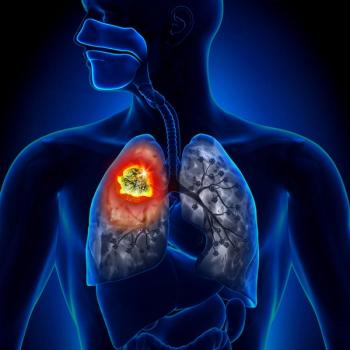
Antitumor Effects Noted With Infigratinib in FGFR2+ Cholangiocarcinomas Refractory to Chemotherapy
Encouraging efficacy and safety outcomes were reported at the 2021 Gastrointestinal Cancers Symposium when infigratinib was used to treat FGFR2 fusion–positive cholangiocarcinomas that are refractory to chemotherapy.
Chemotherapy-refractory cholangiocarcinomas harboring FGFR2 fusions responded well to infigratinib treatment and revealed an acceptable safety profile for the agent, according to final results from cohort 1 of a phase 2 trial (NCT02150967) presented during the 2021 Gastrointestinal Cancers Symposium.1
The TKI elicited an objective response rate (ORR) per blinded independent review (BIR) of 23.1% (95% CI, 15.6%-32.2%) in a total of 108 patients with advanced/metastatic cholangiocarcinoma. The ORR was comprised of 1 complete response and 24 partial responses; 66 participants achieved stable disease with the agent, while 11 experienced disease progression. The median duration of response (DOR) was 5.0 months (95% CI, 0.9-19.1).
“Infigratinib is an oral, FGFR1-3 selective TKI that shows meaningful clinical activity against chemotherapy-refractory cholangiocarcinoma containing FGFR2 fusions,” lead study author Milind Javle, MD, professor in the Department of Gastrointestinal Medical Oncology of the Division of Cancer Medicine at The University of Texas MD Anderson Cancer Center, said during an oral presentation of the data. “Infigratinib, administered as second- and later-line treatment, represents a new therapeutic option for [these] patients.”
Approximately 14% of patients with intrahepatic cholangiocarcinoma have tumors that harbor FGFR fusions, and second-line chemotherapy appears to have limited efficacy in these patients. Previously, however, infigratinib has been shown to have preliminary activity in tumors that harbor these aberrations.2 For example, results from a phase 2 trial (NCT02150967) showed that the agent elicited an ORR of 14.8% in patients with FGFR-altered advanced disease, with a disease control rate (DCR) of 75.4%.3 Notably, in patients with FGFR2 fusions only, these rates were 18.8% and 83.3%, respectively.
The open-label, phase 2 trial enrolled 140 patients with unresectable locally advanced or metastatic cholangiocarcinoma who had either progressed on or were intolerant to gemcitabine-based chemotherapy. To be eligible for enrollment, all participants had to have either FGFR gene fusions or rearrangements.
Patients were assigned to 1 of the 3 cohorts: patients with FGFR2 gene fusions or rearrangements comprised cohort 1 (n = 120), those with FGFR1 and FGFR3 gene fusions or rearrangements and/or FGFR mutations comprised cohort 2 (n = 20), and those with FGFR2 gene fusions who had progressed after previous treatment with a selective FGFR inhibitor beyond infigratinib were included in cohort 3 (n = 20).
Patients received single-agent infigratinib at a daily dose of 125 mg for 21 days in 28-day treatment cycles. The co-primary end points of the trial were ORR and DOR, while key secondary end points included progression-free survival (PFS), DCR, best overall response (BOR), overall survival (OS), safety, and pharmacokinetics.
Results presented during the 2021 Gastrointestinal Cancers Symposium were focused on cohort 1, which enrolled a total of 122 patients; 14 patients were excluded from the analysis because they had other genetic alterations such as FGFR1/3. A total of 108 patients with FGFR2 fusions or rearrangements were included in the protocol-defined analysis population. Of these patients, 107 received previous gemcitabine-based treatment, 88 had FGFR2 fusions, and 20 had FGFR2 gene rearrangements.
At the time of data cutoff, 96 patients had discontinued treatment with the study drug. The majority (n = 67), discontinued due to disease progression, while 15 did so because of toxicity, and 9 because of clinical progression. Moreover, 3 discontinuations were due to patient decision, 1 was due to death, and 1 patient was lost to follow-up. A total of 12 patients were still receiving treatment with infigratinib at the time of data cutoff.
The most common FGFR2 fusion partner was BICC1, which was observed in 25% (n = 27) of patients, followed by AHCYL1, which was noted in 3.7% (n = 4) of patients. “Interestingly, 35% of patients had novel fusion partners,” noted Javle.
The median age of study participants “was relatively low,” according to Javle, at 53 years. The majority of patients, or 62%, were female. Moreover, 72.2% of patients were white, 10.2% were Asian, 3.7% were Black or African American, and 13.9% were other or unknown. The majority of patients had an ECOG performance status of 1 (57.4%; n = 62) and stage IV disease at the time of study entry (99.1%; n = 107). Just under 70% of patients had metastases in the lung, while 57.4% had them in the lymph nodes, and 25.9% had them in the bone.
“This was an extensively pretreated population, with a median of 2 prior lines of therapy,” noted Javle. “In fact, [approximately] 46% of patients had 1 or less lines of therapy, and the rest had 2 or more prior lines of therapy.”
Additional results revealed that the BOR was 34.3% (95% CI, 25.4-44.0) and median time to response with infigratinib was 3.6 months (range, 1.4-7.4); the DCR with infigratinib was 84.3% (95% CI, 76.0-90.6). Per investigator assessment, the confirmed ORR was 30.6% and the median duration of response was 6.0 months (range, 5.2-9.0).
Additionally, the median PFS in these patients per BIR was 7.3 months (95% CI, 5.6 -7.6), with a 4-month PFS rate of 75.2% (95% CI, 65.2-82.7). The median OS was 12.2 months (95% CI, 10.7-14.9) in this population.
“Interestingly, the clinical activity with infigratinib may depend on prior lines of chemotherapy,” said Javle.
The ORR in patients who received 1 or less prior lines of therapy was 34.0% (95% CI, 21.2-48.8) versus just 13.8% (95% CI, 6.1-25.4) in those who received 2 or more prior lines of treatment; this translated to a BOR that was superior in the subgroup who received 1 or fewer prior lines of treatment, at 42.0% (95%, 28.2-56.8) versus 27.6% (95% CI, 16.7-40.9), respectively. Additionally, the DCR in the patients who received fewer prior lines of treatment was 88.0% (95% CI, 75.7-95.5) versus 81.0% (95% CI, 68.6-90.1) in those who received 2 or more prior lines.
“However, there was no [significant] difference in terms of DOR or median PFS,” added Javle. The DOR in those who received 1 or fewer lines of previous treatment was 5.6 months (range, 3.7 months-9.5 months) versus 4.9 months (95% CI, 3.7 months–not evaluable). The median PFS in these subgroups was 7.3 months (95% CI, 5.6-9.3) versus 7.4 months (95% CI, 5.6-7.7), respectively.
“The vast majority of patients experienced benefit in terms of either stable disease or partial response,” added Javle. All subgroups of patients appeared to benefit with infigratinib, irrespective of gender, age, baseline ECOG performance status, disease stage at time of study entry, and region; those who received fewer lines of therapy achieved the most benefit.
The majority of toxicities reported with infigratinib were grade 1 or 2 in severity; these adverse effects (AEs) were found to be both reversible and easily managed. The most frequently reported AEs were mechanism based; they included calcium phosphate homeostasis (85.2%), tissue calcification (2.8%), pathological fracture (0.9%), vascular calcification/mineralization (0.9%), and eye disorders (70.4%). Central serous retinopathy/retinal pigment epithelial detachment–like events occurred in 16.7% of patients.
Infigratinib is now under exploration in a phase 3 trial (NCT03773302), which is evaluating its safety and efficacy compared with standard-of-care gemcitabine or cisplatin in the frontline treatment of patients with unresectable locally advanced or metastatic cholangiocarcinoma with FGFR2 gene fusions or translocations.4
References:
- Javle M, Roychowdhury S, Kelley RK, et al. Final results from a phase 2 study of infigratinib (BGJ398), a FGFR-selective tyrosine kinase inhibitor, in patients with previously-treated advanced cholangiocarcinoma containing FGFR2 fusions/rearrangements. J Clin Oncol. 2021;39(suppl 3):265. http://bit.ly/3oX1njs.
- Guagnano V, Kauffmann A, Wöhrle S, et al. FGFR genetic alterations predict for sensitivity to NVP-BGJ398, a selective pan-FGFR inhibitor. Cancer Discov. 2012;2(12):1118-1133. doi:10.1158/2159-8290.CD-12-0210
- Javle M, Lowery M, Shroff RT, et al. Phase II study of BGJ398 in patients with FGFR-altered advanced cholangiocarcinoma. J Clin Oncol. 2018;36(3):276-282. doi:10.1200/JCO.2017.75.5009
- Phase 3 study of BGJ398 (oral infigratinib) in first line cholangiocarcinoma with FGFR2 gene fusions/translocations. ClinicalTrials.gov. Updated December 22, 2020. Accessed January 17, 2021. https://clinicaltrials.gov/ct2/show/NCT03773302.
Newsletter
Stay up to date on recent advances in the multidisciplinary approach to cancer.



















































































